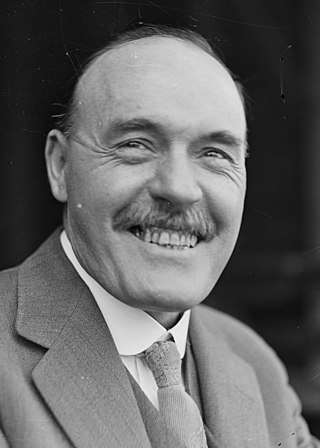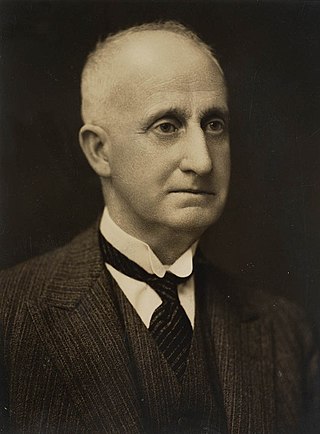
John Thomas Lang, usually referred to as J. T. Lang during his career and familiarly known as "Jack" and nicknamed "The Big Fella", was an Australian politician, mainly for the New South Wales Branch of the Labor Party. He twice served as the 23rd Premier of New South Wales from 1925 to 1927 and again from 1930 to 1932. He was dismissed by the Governor of New South Wales, Sir Philip Game, at the climax of the 1932 constitutional crisis and resoundingly lost the resulting election and subsequent elections as Leader of the Opposition. He later formed Lang Labor that contested federal and state elections and was briefly a member of the Australian House of Representatives.

Sir Philip Woolcott Game, was a British Royal Air Force commander, who later served as Governor of New South Wales and Commissioner of Police of the Metropolis (London). Born in Surrey in 1876, Game was educated at Charterhouse School and entered the military at Royal Military Academy Woolwich, gaining his commission in 1895. Serving with the Royal Artillery, Game saw action in the Second Boer War and the First World War. After serving with distinction and bravery, Game transferred to the Royal Flying Corps in early 1916 serving as General Trenchard's chief staff officer. Finishing the War as an acting major-general, Game remained in the Royal Air Force after the close of hostilities. Notably he served as Air Officer Commanding RAF India and Air Member for Personnel. He retired from the military in 1929, having reached the rank of air vice-marshal.

Robert James Heffron, also known as Bob Heffron or R. J. Heffron, was a long-serving New South Wales politician, union organiser and Labor Party Premier of New South Wales from 1959 to 1964. Born in New Zealand, Heffron became involved in various Socialist and labour movements in New Zealand and later Australia before joining the Australian Labor Party. Being a prominent unionist organiser, having been gaoled at one stage for "conspiracy to strike action", he was eventually elected to the Parliament of New South Wales for Botany in 1930. However his disputes with party leader Jack Lang led to his expulsion from the ALP in 1936 and Heffron formed his own party from disgruntled Labor MPs known as the Industrial Labor Party. The success of his party enabled his readmission to the party and his prominence in a post-Lang NSW Branch which won office in 1941.
A referendum concerning reform of the New South Wales Legislative Council was put to New South Wales voters on 25 May 1991. The referendum coincided with that year's New South Wales general election. The change passed comfortably. The text of the question was:
Do you approve of the Bill entitled 'A Bill for an Act:
(a) to reduce the number of politicians in the Legislative Council and to reduce their maximum term of office; and
(b) to apply to the Legislative Council the same method of filling casual vacancies as applies to the Senate ?
Macquarie, until 1910 The Macquarie was an electoral district of the Legislative Assembly in the Australian state of New South Wales, created in 1894 and named after the Macquarie River. It was re-created in 1904, retaining nothing but the name, then abolished in 1920.

John Estell was a politician and coal miner in New South Wales, Australia. He was a member of the New South Wales Parliament for 29 years, including 20 years in the Legislative Assembly. He was a minister in the Holman, Storey and Dooley Labor governments.
The Australian Labor Party (New South Wales Branch), also known as NSW Labor, is the New South Wales branch of the Australian Labor Party. The parliamentary leader is elected from and by the members of the party caucus, comprising all party members in the Legislative Assembly and Legislative Council. The party factions have a strong influence on the election of the leader. The leader's position is dependent on the continuing support of the caucus (and party factions) and the leader may be deposed by failing to win a vote of confidence of parliamentary members. By convention, the premier sits in the Legislative Assembly, and is the leader of the party controlling a majority in that house. The party leader also typically is a member of the Assembly, though this is not a strict party constitutional requirement. Barrie Unsworth, for example, was elected party leader while a member of the Legislative Council. He then transferred to the Assembly by winning a seat at a by-election.
A referendum concerning the abolition of the New South Wales Legislative Council was put to New South Wales voters on 29 April 1961. The abolition was specifically rejected by voters. The text of the question was:
Do you approve of the Bill entitled "A Bill for an Act to Abolish the Legislative Council to provide that another Legislative Council shall not be created, constituted or established nor shall any Chamber, Assembly or House, other than the Legislative Assembly, designed to form part of the Legislative Parliament of New South Wales, be created, constituted or established until a bill for the purpose has been approved by the electors in a referendum to amend the Constitution Act, 1902 and certain other Acts; and for purposes connected therewith."

Robert Reginald Downing, was an Australian lawyer, textile worker, union organiser and politician. He was a member of the New South Wales Legislative Council for the Labor Party for 31 years from 1940 to 1972 and also served as the Attorney General, Minister for Justice and Vice-President of the Executive Council from 1941 to 1965.

The Heffron ministry (1959–1962) or First Heffron ministry was the 59th ministry of the New South Wales Government, and was led by the 30th Premier, Bob Heffron, of the Labor Party. The ministry was the first of two consecutive occasions when the Government was led by Heffron, as Premier.

Sir Henry Edward Manning, KBE QC was an Australian lawyer and politician. He was a member of the New South Wales Legislative Council for 25 years from 1932 to 1958 and also served as the Attorney General and Vice-President of the Executive Council from 1932 to 1941.
Members of the New South Wales Legislative Council between 1949 and 1952 were indirectly elected by a joint sitting of the New South Wales Parliament, with 15 members elected every three years. The most recent election was on 31 March 1949, with the term of new members commencing on 23 April 1949. The President was Ernest Farrar.

Sir John Beverley Peden was an Australian jurist and politician. Born in Randwick to farmer Magnus Jackson Peden, a mayor of Randwick, and Elizabeth Neathway Brown, he attended public school at Bega before studying at Sydney Grammar School and the University of Sydney, where he received a Bachelor of Arts in 1892 and a Bachelor of Laws in 1898. He was an assistant lecturer in Latin at the university from 1896 to 1898, when he was called to the bar. He lectured in law from 1903 and became a professor and faculty dean in 1910. Appointed to the New South Wales Legislative Council as a Nationalist in 1917, from 1929 to 1946 he was president of the council; he was both the last president appointed directly by the governor, and the first elected by his fellow councillors. Peden died in Paddington in 1946.
Carl Adrian Akhurst was an Australian accountant, secretary and politician who served as a Member of the Legislative Council of New South Wales from 1925 to 1934. Initially appointed by the Governor of New South Wales as one of 25 Labor Party appointees, Akhurst was expelled from the party after failing to vote for the Council's abolition in 1926. Readmitted to the Federal Labor Party in 1931, Akhurst unsuccessfully sought re-election as the ALP candidate to the council in 1940.
John Whitehead Percival was an English-born Australian politician.
Members of the New South Wales Legislative Council who served from 1930 to 1932 were appointed for life by the Governor on the advice of the Premier. This list includes members between the 1930 state election on 25 October 1930 and the 1932 state election on 11 June 1932. The President was Sir John Peden. The Premier Jack Lang had been seeking to swamp the council, however the Governor Sir Philip Game had declined to do so in November 1930, March, June and September 1931 when Lang sought 70 new members be appointed. In November 1931 Lang dropped his request to 25 new members and the governor agreed to the request. This raised the number of members of the council from 85 to 110.
Members of the New South Wales Legislative Council who served from 1925 to 1927 were appointed for life by the Governor on the advice of the Premier. This list includes members between the 1925 state election on 30 May 1925 and the 1927 state election on 8 October 1927. The President was Fred Flowers. The Labor platform included the abolition of the Legislative Council. At the opening of the new parliament on 24 June 1925 there were 75 members of the council, with just 23 Labor members and Premier Jack Lang had been seeking to appoint 25 new members, however the Governor Sir Dudley de Chair had declined to do so in September 1925. In December the Governor agreed to make the appointments in circumstances that are disputed. De Chair understood there was an agreement that the appointments would not be used to abolish the Legislative Council, while Lang said he gave no such undertaking. All 25 appointees took the pledge to implement the Labor platform, "including the abolition of the Legislative Council", similar to that signed by other Labor members.

The Constitution Act 1902 is the founding document of the State of New South Wales, and sets out many of the basic principles of the Government of New South Wales. This act created the foundation of the Executive, Legislative and Judicial branches of the Government of New South Wales. Most of the Constitution can be amended through ordinary Acts of Parliament, however some sections can only be amended through a referendum of NSW voters.
The 1978 New South Wales referendum was held on 17 June 1978 and contained a single question:
Do you approve of the Bill entitled 'A Bill for an Act to provide for the election of members of the Legislative Council directly by the people'.
There have been 18 referendums in New South Wales, 8 of which concerned proposals to amend the New South Wales Constitution, half of which concerned the Legislative Council. While the Constitution of Australia was adopted after the 1898 and 1899 referendums in all of the proposed states, the constitution of New South Wales, promulgated in 1902, was an Act of the Parliament of New South Wales which could be amended by parliament. Since 1927 the constitution has included provisions that can only be amended following approval in a referendum. 8 of the referendums, including 5 on the sale of alcohol, did not involve any proposed amendment to the constitution. While these have traditionally been called referendums, they could also be described as plebiscites.







